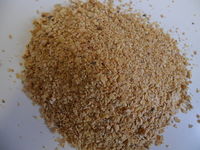Protein Concentrates and Sources
Oilseed Meals
These include: Soyabean, Cottonseed, Rapeseed, Linseed, Sunflowerseed meals

Characteristics
Soyabean meal, cottonseed meal, rapeseed meal, linseed meal and sunflowerseed meal belong to the oilseed meal family. Oilseed meals are by-products and residues following the removal of oil from the seeds. They are a very good protein source with high digestibility and are a better source of calcium and phosphorus than cereals.
| DM (%) | ME (MJ/kg DM) | CP (g/kg DM) | |
|---|---|---|---|
| Soyabean meal | 90 | 13.3 – 15.5 | 400 - 500 |
| Cottonseed meal | 90 | 8.5 – 12.5 | 230 - 450 |
| Rapeseed meal | 90 | 12 | 400 |
| Linseed meal | 90 | 12 | 400 |
| Sunflowerseed meal | 90 | 9.5 – 10.5 | 300 - 430 |
Associated Problems
Soyabeans are oestrogenic, goitrogenic and can contain high levels of lectins. Cottonseeds are low in essential amino acids, calcium and vitamins A and D, and can contain elevated levels of gossypols. Rapeseeds are goitrogenic and can contain elevated levels of tannins. Immature linseed has mucilage that is converted to hydrogen cyanide. Sunflowerseeds cause soft body fat in pigs due to high PUFA levels.
Leguminous Seeds
These include: Peas, Beans (broad, horse, Windsor) and Lupin seeds
Characteristics
Leguminous seeds consists of peas, beans (broad, horse, windsor) and lupin (white, blue and yellow varieties) seeds. Leguminous seeds have a high protein content, good energy content and high phosphorus concentration, but tend to be low in calcium. Leguminous seeds can be eaten whole or processed (cracked, kibbled or ground). They are often used in place of other protein concentrations.
| DM (%) | ME (MJ/kg DM) | CP (g/kg DM) | |
|---|---|---|---|
| Peas | 86 | 13.8 | 260 |
| Beans | 86 | 13.4 | 280 |
| Lupin seed meal | 90 | 13.2 | 280 - 420 |
Associated Problems
Some bean species may contain high levels of lectins. Lupin seeds may contain high levels of alkaloids (e.g. ergotamine). Can be associated with GI tract disturbances (colic, diarrhoea).
Fishmeal
There are other types of animal protein such as meat & bone and blood meal. However, due to the UK and EU restrictions ruminants and non-ruminants must not be fed processed meat & bone or blood meal. Only farmed fish are permitted bloodmeal.
Characteristics
Due to EU/UK restrictions, fishmeal can only be used in unweaned calf milk replacers in ruminants. Pigs, poultry and horses are permitted fishmeal. Fishmeal is typically included in small amounts and has many essential amino acids, vitamins and minerals. Contains high levels of calcium and phosphorus. UK produced fishmeal tends to be slightly lower nutritive value than herring or South American derived fishmeal.
| DM (%) | ME (MJ/kg DM) | CP (g/kg DM) | |
|---|---|---|---|
| Fishmeal | 91 | 14.5 - 18 | 700 - 800 |
| Meat and Bone Meal | 90 | 10 | 600 |
| Blood Meal | 87 | 12.8 | 920 |
Associated Problems
High intakes of fishmeal are associated with taint of meat and eggs.
Urea
Characteristics
A misnomer as not technically a protein, but it does have a CP equivalent to 2,900g/kg DM. In ruminants, the rumen microflora hydrolyse urea to ammonia. Urea is often supplemented to diets of low protein concentration and can also be contained in molassed vitamin/mineral blocks. Urea may be used to treat straw (urine sometimes used in some developing countries), where it effectively improves digestibility of this low quality roughage.
Associated Problems
Less than one-third of the dietary nitrogen should be provided as urea in order to minimise ammonia toxicity. Signs of ammonia toxicity include bloat, twitching, ataxia, excessive salivation and death.
| Protein Concentrates and Sources Learning Resources | |
|---|---|
 Test your knowledge using flashcard type questions |
Animal Nutrition Flashcards |


